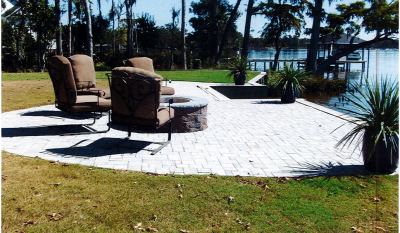MOREHEAD CITY – A couple in Perquimans County was denied their petition to the state Coastal Resources Commission for a variance to allow their patio and fire pit built without required permits and within a 30-foot protective buffer zone to remain on their coastal waterfront property.

The CRC during its meeting Feb. 27 at the History Museum of Carteret County denied the requested variance for the 450-square-foot brick patio and fire pit, which the Division of Coastal Management discovered in September 2017 and found it to be in violation of the state Coastal Area Management Act, or CAMA.
Supporter Spotlight
The couple, Thomas and Judith Lampley of 108 Virginia Court in Hertford, obtained a permit in 2007 for a bulkhead along Yeopim Creek, which is designated as SC waters, meaning tidal salt waters protected for secondary recreation such as fishing, boating, and other activities involving minimal skin contact. The creek is closed to shellfish harvesting.
The 30-foot buffer rule, which applies to all non-oceanfront coastal shorelines, was put in place to reduce development and impervious surfaces along the shoreline and keep structures away from hazards caused by coastal storms, erosion and flooding. The rule has some flexibility. There is an exception for patios of up to 200 square feet built within the buffer using elevated, slatted wood decking and no variance is needed for this type of deck with a moveable fire pit. But the Lampleys’ patio, which they had built in April 2017 without consulting with DCM about any needed permits, was more than twice the allowable size and made of impervious pavers.
A DCM field representative saw the patio during a site visit for a CAMA general permit for a dock in September 2017. DCM on Sept. 25, 2017, issued a notice of violation that included a restoration plan. A continued notice of violation was issued to the Lampleys in November 2017.
The CRC may be petitioned for a variance for a project prohibited by CAMA or the CRC’s development standards after the permit is denied, according to the Department of Environmental Quality. However, permit denial is required to begin the variance process.
According to information provided to CRC, the Lampleys say that they were unaware a permit was required to build the patio and fire pit. DCM staff said there were opportunities for the Lampleys to do their due diligence. “Staff contend that the Petitioners’ stated lack of awareness of the 30’ Buffer is not a reason to grant a variance,” according to the packet.
Supporter Spotlight
At their request, the Lampleys and Sen. Bob Steinburg, R-Beaufort, who was a state representative at the time, met with DCM Director Braxton Davis to discuss options. The Lampleys decided to pursue the variance process, seeking both a procedural variance and substantive variance. The Lampleys last summer applied for a CAMA minor permit to keep the patio and fire pit and received the anticipated denial July 30, 2018.
Through their attorney the Lampleys filed in August 2018 a variance request seeking both the procedural variance and the substantive variance in order to allow the existing patio and fire pit to remain. After filing the request, the Lampleys had the project reviewed by two engineering firms to support their claim that the way the paver patio and fire pit had been built allowed sufficient drainage and features preventing runoff into the creek.
During the CRC meeting Feb. 27, the commission granted the procedural variance from the rule requiring restoration of the affected area before proceeding with the substantive variance, which would allow the patio and fire pit to remain in the 30-foot buffer, but the substantive variance was denied.
With the denial, the petitioners may appeal the decision to Superior Court within 30 days of receipt of the CRC’s decision, according to DEQ.







